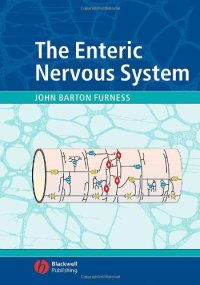
Ebook: The Enteric Nervous System
Author: John Barton Furness
- Genre: Medicine
- Year: 2006
- Publisher: Wiley-Blackwell
- Edition: 1
- Language: English
- pdf
Chapter 1: Structure of the enteric nervous system-The enteric plexuses-Interconnections between the plexuses-Extent of the ganglionated plexuses-Intramural extensions of extrinsic nerves-Electron microscope studies-Enteric glia-The structural similarities and functional differences between regions may have an evolutionary basis-Development of the enteric nervous system-Maturation of enteric neurons and development of function-Changes in enteric neurons with ageing-Summary and conclusionsChapter 2: Constituent neurons of the enteric nervous system-Shapes of enteric neurons-Cell physiological classifications of enteric neurons-Functionally defined enteric neurons-Neurons in human intestine with equivalence to those investigated in laboratory animals-Summary and conclusionsChapter 3: Reflex circuitry of the enteric nervous system-Evolution of ideas about enteric circuitry-Motility controlling circuits of the small and large intestine-Intrinsic secretomotor and vasomotor circuits-Assemblies of neurons-Circuits in the esophagus and stomach-Co-ordination of motility, secretomotor and vasomotor reflexes-Circuits connecting the intestine, biliary system and pancreas-Sympathetic innervation of the gastrointestinal tract-Summary and conclusionsChapter 4: Pharmacology of transmission and sites of drug action in the enteric nervous system-Chemical coding and multiple transmitters-Transmitters of motor neurons that innervate the smooth muscle of the gut-Transmitters at neuro-neuronal synapses-Sites within the reflex circuitry where specific pharmacologies of transmission can be deduced to occur-Transmission from entero-endocrine cells to IPANs-Roles of interstitial cells of Cajal in neuromuscular transmission-Transmitters of secretomotor and vasodilator neurons-Synapses in secretomotor and vasodilator pathways-Transmitters of motor neurons innervating gastrin cells-Summary and conclusionsChapter 5: Neural control of motility-Rhythmic activity of gastrointestinal muscle-Structure and properties of interstitial cells of Cajal-Relationship between slow wave activity and neural control-Gastric motility-Patterns of small intestine motility and their intrinsic neural control-Motility of the colon-Neural control of the esophagus-Gall-bladder motility-Sphincters-Muscle of the mucosa-Mechanism of sympathetic inhibition of motility in non-sphincter regions-Sympathetic innervation of the sphincters-Physiological effects of noradrenergic neurons on motility in undisturbed animals-Reflex activities of sympathetic neurons that affect motility-Summary and conclusionsChapter 6: Enteric neurons and the physiological control of fluid secretion and vasodilation-Water and electrolyte secretion in the small and large intestines-Reflex control of water and electrolyte secretion-Secretion of gastric acid-Pepsinogen secretion-Gastric secretion of bicarbonate-Secretion into the gall bladder-Pancreatic exocrine secretion-Summary and conclusionsChapter 7: Disorders of motility and secretion and therapeutic targets in the ENS-Therapeutic end-points for motility disorders-Enteric neuropathies involving neuronal loss or phenotypic changes-Mitochondriopathies with intestinal manifestations-Irritable bowel syndrome and plasticity of enteric neurons-Summary and conclusions
Download the book The Enteric Nervous System for free or read online
Continue reading on any device:

Last viewed books
Related books
{related-news}
Comments (0)